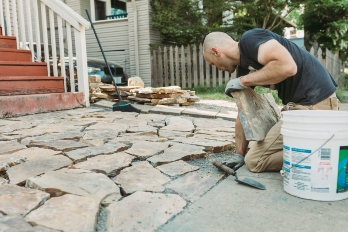Could your yard use a little spring cleaning? With the days getting longer and the weather warming up, we’re all eager to get outside for some fresh air, even if it’s just to tackle some cleanup projects first. But DIY maintenance can be more difficult than expected, so we rounded up a few hacks to make your amateur landscaper life easier (and safer). With these tricks and shortcuts, your outdoor space will be ready for sunny barbecues no time.
- Head out prepared
Before you head outside, gather all your supplies ahead of time. Be sure to sharpen your tools, like pruners, sheers and hedge clippers to make clipping a simpler task (plants heal faster when cuts are clean, too). Supplies you’ll need include:
- Tarps
- Ladder
- Sheers and hedge clippers
- A leaf blower, if you have one
- Garden gloves
- Bungee cords or twine
- 5-gallon bucket or a wheelbarrow (for collecting sticks and other debris)
- Gutter Check
By the end of winter, gutters are stuffed with leaves and sticks, which can stop them from performing their intended purpose: to collect and drain out water. If the contents in your gutters are wet, wear rubber gloves to keep your hands dry while cleaning them out. (Also, head to the American Ladder Association for ladder safety tips). Overwhelmed by the soppy mess? A wet-vac can handle this job for you.
If your gutters are dry, a leaf blower is another quick way to clear them out. It’ll send the mess to the ground, but you’re going to clean that up anyway.
- Bungee tall grasses
Bunches of ornamental grasses can be very pretty decorations in a yard – they can also be confusing to trim. Unless you feel like trying your hand at hairdressing, gather the plants together with a bungee cord or twine, then chop at the top. Cut them as low as possible so they have plenty of room to grow before needing another snip.
- Move waste en masse
Find that clearing away lawn waste takes forever? It’s time to wake … er … we mean, rake up – the right way! First, put leaves into rows instead of circular piles, and take off small portions at a time for bagging. Have a designated spot on your property for lawn debris? Rake bunches onto tarps to drag them to your leaf pile. These hauls can get heavy if leaves are wet though, so go easy on how much you bring per trip, or grab a buddy to help.
- Compost debris
Looking to protect the environment and your budget at the same time? Rather than throwing yard waste away in garbage bags, or storing it in an unattended pile, give composting a shot instead. Use chicken-wire or other fencing to build a 3×3-foot (or bigger) DIY compost bin, and fill it with leaves, twigs, last year’s mulch and other scraps. Turn the compost with a pitchfork every few weeks to help the contents decompose and in a short time, you’ll have a stockpile of homemade mulch for the season.
Compost tip: Keep invasive vines, allergens like poison ivy and sumac, and anything that’s sprouting roots out, as they can grow inside the compost or cause rashes when you clear it out later.
- Grab a beer
Just kidding. Consuming alcohol while operating sharp landscaping tools isn’t recommended! But when you’re finished cleaning off your lawn and garden beds, your soil could use a little fertilizer after the long, nutrient-void winter. Rather than splurging on the expensive stuff, combine a leftover can of beer with 1/2 cup each of baby shampoo and ammonia until the mixture is a liquid and spray it on areas that could use a little love. If you do have some soil food lying around, add some in as a mineral supplement.
Ammonia, you say? Isn’t that a dangerous chemical that would surely harm your lawn? That’s what we thought at first too, but ammonia is made up of nitrogen, a chemical element plants crave. For safe handling, go outside or open a nearby window, and wear protective gloves and even eyewear. If you have asthma, it may be best to avoid the substance altogether.
Tackling your kitchen next? Check out our post, 5 Easy Ways to Keep Up With Kitchen Maintenance.





Leave a Reply